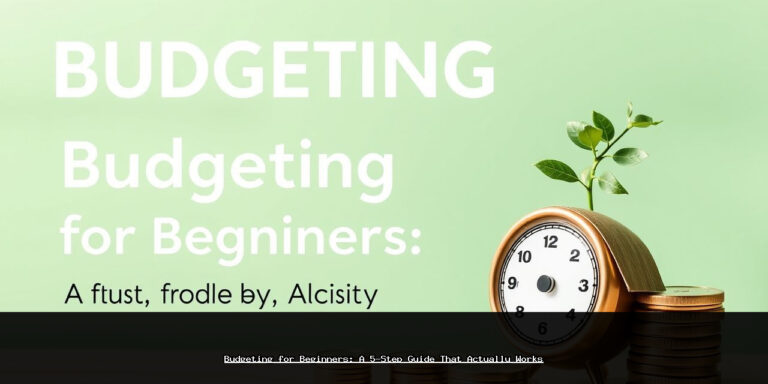The Envelope Budgeting Method: Still Worth It in 2025?
Table of Contents
- Introduction
- What Is the Envelope Budgeting Method?
- Pros of Envelope Budgeting in 2025
- 1. Psychological Spending Control
- 2. Simplicity and Transparency
- 3. Debt Reduction Success
- Cons of Envelope Budgeting in 2025
- 1. The Cashless Society Problem
- 2. Security Risks
- 3. No Automation or Rewards
- Modern Alternatives to Traditional Envelopes
- 1. Digital Envelope Apps
- 2. Hybrid Approach
- 3. AI-Powered Budgeting
- Case Study: Envelopes vs. Digital in 2024
- Who Should Still Use Envelopes in 2025?
- The Bottom Line
- Conclusion
The Envelope Budgeting Method: Still Worth It in 2025?
Meta Title: Envelope Budgeting in 2025: Does It Still Work?
Meta Description: Discover if the cash-based envelope budgeting method is still effective in today’s digital economy. Pros, cons, and modern alternatives.
Introduction
The envelope budgeting system—a century-old cash management strategy—has survived economic downturns, recessions, and even the rise of digital banking. But does it still hold up in 2025, when contactless payments, digital wallets, and AI-powered budgeting apps dominate personal finance?
What Is the Envelope Budgeting Method?
Developed in the early 1900s, the envelope system is straightforward:
- Divide your monthly income into spending categories (e.g., groceries, dining, entertainment).
- Allocate a fixed cash amount for each category into physical envelopes.
- Once an envelope is empty, you stop spending in that category until the next budget cycle.
Its core principle is enforcing discipline by making spending tangible. But does that still work in a world where 78% of transactions are cashless (Federal Reserve, 2024)?
Pros of Envelope Budgeting in 2025
1. Psychological Spending Control
Studies show that people spend 15-20% less when using cash (MIT, 2023). Physically handing over money triggers pain receptors in the brain, making you reconsider unnecessary purchases—something digital payments bypass.
2. Simplicity and Transparency
No algorithms, no sync errors. Just a visual, hands-on way to track spending—ideal for those overwhelmed by apps like Mint or YNAB.
3. Debt Reduction Success
A 2024 Consumer Finance Review study found that envelope budgeters reduced credit card debt 27% faster than digital-only users, thanks to enforced spending limits.
Cons of Envelope Budgeting in 2025
1. The Cashless Society Problem
With 62% of U.S. businesses now cashless (Square, 2024), relying solely on envelopes can be impractical. Try splitting a dinner bill with friends using exact change.
2. Security Risks
Carrying cash increases theft vulnerability. The FBI reported a 12% rise in physical wallet thefts in 2023 compared to pre-pandemic levels.
3. No Automation or Rewards
You miss out on credit card points, cashback, and automated savings tools that apps like Qapital or Digit provide—costing the average user $300+ annually in lost rewards (NerdWallet, 2024).
Modern Alternatives to Traditional Envelopes
1. Digital Envelope Apps
Tools like Goodbudget and Mvelopes replicate the system digitally, linking to bank accounts while maintaining category limits.
2. Hybrid Approach
Use cash for high-temptation categories (e.g., dining out) and digital tools for fixed bills (rent, utilities). A 2024 Money Magazine survey found this was the most sustainable method for 68% of users.
3. AI-Powered Budgeting
Apps like Copilot analyze spending patterns and adjust envelope limits dynamically—something impossible with physical cash.
Case Study: Envelopes vs. Digital in 2024
Sarah T., a freelance designer, tested both methods for six months:
- Physical envelopes: Cut her discretionary spending by $220/month but struggled with online subscriptions and gas payments.
- Digital envelopes (YNAB): Saved $175/month automatically and earned $42 in cashback—with less hassle.
Her verdict: “I keep one grocery envelope in cash. The rest? My phone handles it.”
Who Should Still Use Envelopes in 2025?
Ideal for:
- Visual learners who need tangible feedback.
- Those rebuilding credit by avoiding cards entirely.
- Families teaching kids money management (68% of parents use envelopes for allowance, per T. Rowe Price, 2024).
The Bottom Line
The envelope method isn’t obsolete—it’s evolved. While pure cash envelopes may not fit 2025’s digital economy, the principle of compartmentalized spending remains gold-standard budgeting advice. The best approach? Blend physical cash for problem categories with digital tools for everything else.
Conclusion
Envelope budgeting in 2025 isn’t about paper vs. pixels—it’s about using whatever method forces you to confront your spending habits. Whether you stick with cash, go digital, or mix both, the core lesson endures: spending with intention beats mindless swiping every time.






